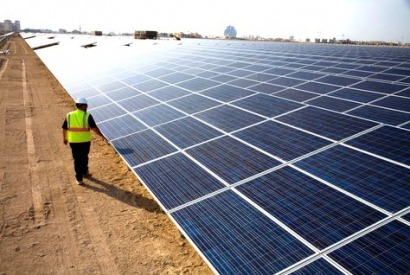
The surfaces of solar panels at PV plants are regularly exposed to sand, dust and other forms of soiling. Under the R&D agreement, Siemens and Masdar Institute, an independent, research-driven graduate-level university focused on advanced energy and sustainable technologies, are focusing on developing coatings and soiling models for these modules that require less water for cleaning than current high performance modules. Another target of these joint R&D efforts is to identify commercial applications for solar technology in the Middle East region.
The collaboration agreement takes advantage of Masdar Institute's ability to provide fundamental insights upon which new solar energy innovations will be developed. The collective efforts aim to tap both Siemens' and Masdar Institute's strengths in the 'research, development, demonstration and deployment' innovation lifecycle. "Both Siemens and Masdar Institute have been working independently on solar energy R&D in the past," said Martin Pfund, CEO of the Siemens Energy Photovoltaic business unit. "With the current agreement we are addressing the special challenges associated with deploying PV panels in the Middle East. Higher revenues gained with solar panels that become less soiled and cost less to clean are an important lever for making photovoltaic electricity competitive, especially in desert regions."
Dr. Steven Griffiths, Executive Director of Institute Initiatives and Professor of Chemical Engineering at Masdar Institute, said: "We are pleased about our cooperation with Siemens, in particular in the domain of solar technology that is of critical importance to the region. Through this joint project we will be making a significant contribution to advancement of the solar energy industry and will be building upon research currently being done with Siemens in the areas of smart grids and smart buildings as well as carbon capture and storage."
"Research to date has shown that solar panel surfaces that have been manipulated and functionalized need less water for cleaning. We have reached this conclusion by making extensive use of atomic force microscopy, which enables us to explore nanoscale phenomena. We are looking for explanations so that these advances can be applied under real operating conditions and are investigating ways of optimizing the functionality of the panel surfaces. One of the aims of our collaboration with Siemens is to promote regional deployment of solar energy," added Dr. Matteo Chiesa.
This agreement is an extension of Masdar Institute's existing partnership with Siemens. According to the previous strategic agreement, Siemens is planning to establish a strategic anchor presence in Masdar City. Siemens' Middle East Headquarters will be moving to Masdar where a Center of Excellence in Building Technologies as well as other initiatives including a Leadership Development Center will be set up. Siemens has already committed to establishing a long-term collaboration with Masdar Institute in the areas of smart grids, smart buildings, and carbon capture and storage in the form of academic programs, scholarships and R&D funding.
Dusting down with space age technology
It has been calcuated that a dust layer of one-seventh of an ounce per square yard decreases solar power conversion by 40%. In deserts, dust is deposited each month at about four times that amount in Arizona, while deposition rates are even higher in the Middle East, Australia, and India.
It is no wonder then that a number of other research groups are working to develop self-cleaning techniques for solar panels. In 2010, for example, researchers at Boston University proposed an innovative solution based on electrodynamic screen (EDS) technology they had developed for NASA space missions.
At a national conference of the American Chemical Society held in 2010, Professor Malay Mazumder from the university reported that the EDS developed by his lab can remove 90% of dust particles from a square metre of PV paneling in two minutes while using just a small amount of electricity generated by the solar panel itself.
A transparent, electrically-sensitive material is deposited on the panels, or on a transparent plastic sheet covering the panels. When dust concentration (monitored by sensors) reaches a critical level, an electric charge is generated in the material, creating a dust-repelling wave that lifts and pushes away the dust.
For additional information:

